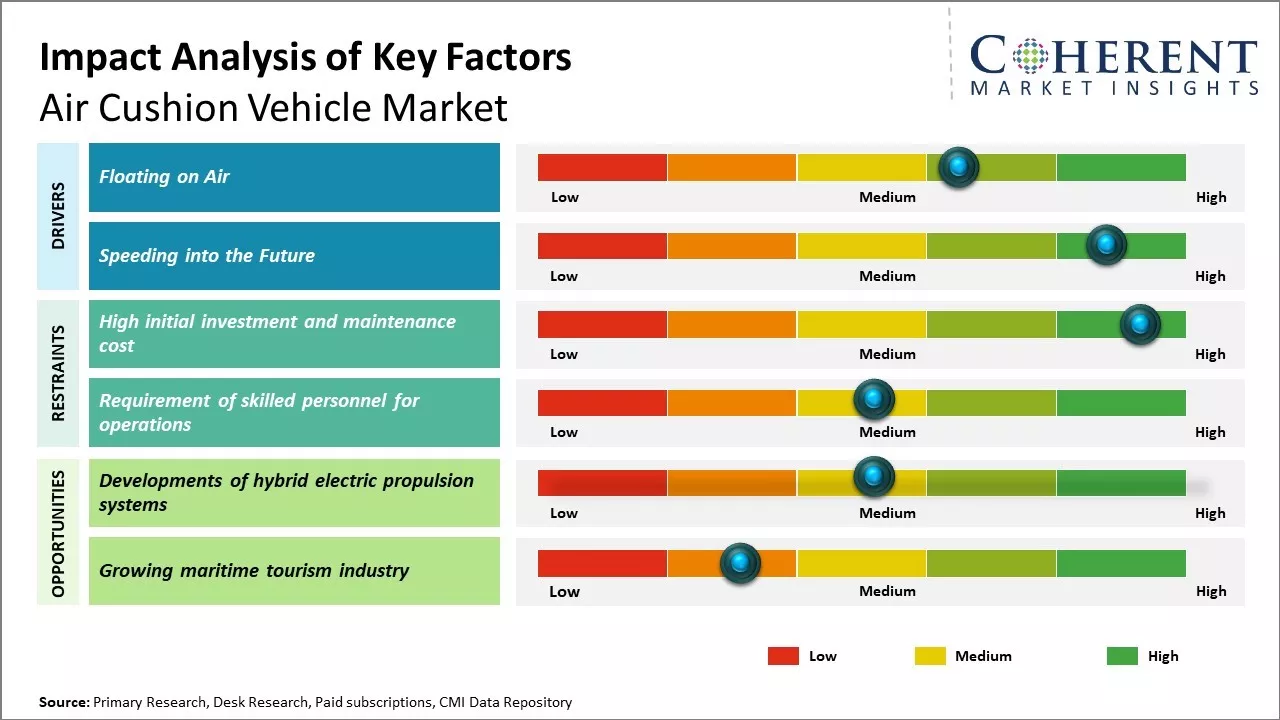The Air Cushion Vehicle Market is estimated to be valued at USD 127.22 Mn in 2024 and is expected to reach USD 174.72 Mn by 2031, growing at a compound annual growth rate (CAGR) of 4.6% from 2024 to 2031.

To learn more about this report, Request sample copy
The air cushion vehicle market is witnessing positive growth trends over the past few years. Factors such as increasing usage of air cushion vehicles for transportation, cargo & logistics applications across various industries such as defense, tourism, and oil & gas are driving the demand. Moreover, advancements in technology to improve efficiency, speed, and payload capacity of air cushion vehicles is further supporting the market growth. However, high manufacturing and maintenance costs associated with air cushion vehicles continue to hinder the broader market adoption. Ongoing research and development efforts for cost-effective materials and designs, along with increasing maritime security threats globally, are anticipated to generate new business prospects for air cushion vehicle manufacturers in the forecast period.
Market Drivers: Floating on Air
As naval forces around the world seek innovative ways to project power from the sea, air cushion vehicles have emerged as a compelling option. These amphibious crafts rely on powerful jet fans to create a cushion of air under the hull, allowing them to "float" inches above the water's surface. This creates a unique capability for high-speed transport and maneuverability in coastal regions and shallow waters. Conventional ships and boats are constrained by their draft, but air cushion vehicles can operate in just inches of water. They are unaffected by changing tides or offshore hazards that would ground other vessels.
This attribute is of intense interest to military planners. Amphibious insertions are a crucial part of modern expeditionary warfare but often depend on having sufficient beachfront or port access. Air cushion vehicles eliminate this dependence by allowing forces to be deposited virtually anywhere along a coastline. Their low draft also lets them covertly approach hostile shores without needing to navigate predictable deep-water channels. This strengthens amphibious readiness options for crisis response. Commercial applications are emerging as well, such as using air cushion technology to resupply remote coastal villages or support offshore industries like aquaculture. As coastal regions worldwide experience greater development and naval powers seek to project flexible and expeditionary capabilities, the market for air cushion vehicles will surely grow.

To learn more about this report, Request sample copy
Speeding into the FutureBeyond their unique amphibious properties, air cushion vehicles also promise high top speeds compared to other marine transit methods. Though limited endurance constraints them primarily to transport roles rather than frontline combat ships, speed remains a vital attribute for delivering troops, equipment, or supplies in expeditionary warfare. It could make the difference between a unit arriving in time to participate in an operation or missing the window of opportunity. Air cushion technology continues to advance, enabling greater payloads and ranges, but the inherent hydrodynamic properties will always give these vehicles an edge in maximum velocity over surface ships, boats, and amphibians.
Commercial operators are taking notice as well. Ferry services desire short travel times to maximize passenger throughput and profitability. Offshore industries may one day use air cushion craft to rapidly shift workers between offshore installations. Search and rescue teams could cover more water in less time to aid those in distress. As cities and populations continue clustering along coastlines, the incentive will grow to quickly transport people and goods over water. Technologies that can achieve new speed records, like advanced air cushion vehicles.
Joining thousands of companies around the world committed to making the Excellent Business Solutions.
View All Our Clients